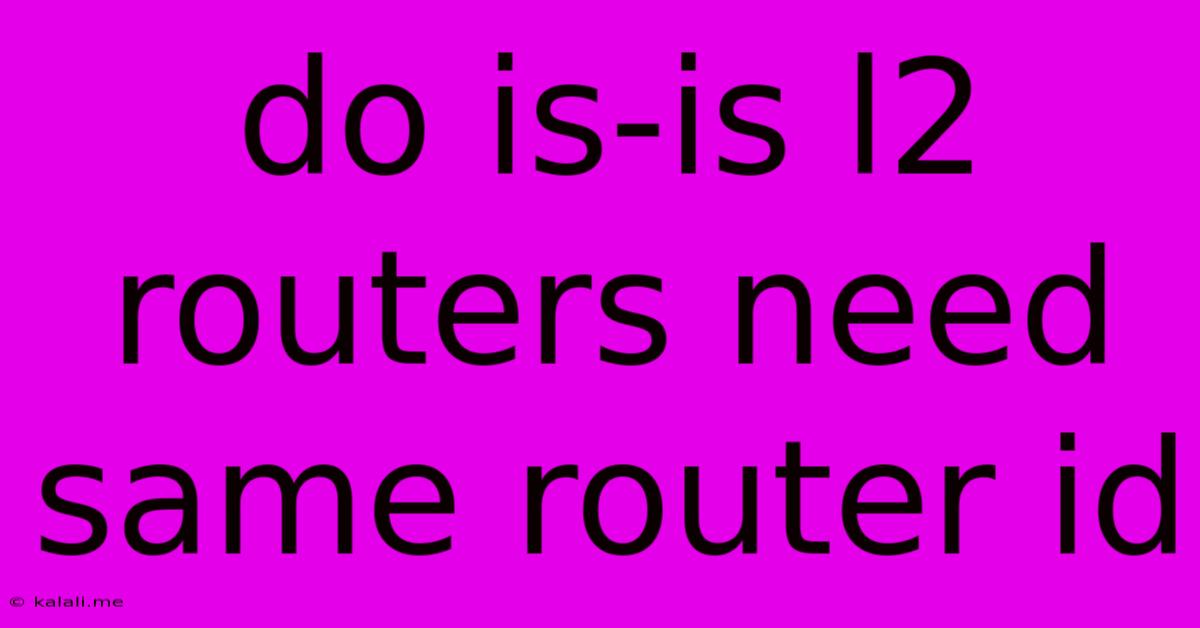Do Is-is L2 Routers Need Same Router Id
Kalali
Jun 03, 2025 · 3 min read

Table of Contents
Do IS-IS L2 Routers Need the Same Router ID?
IS-IS (Intermediate System to Intermediate System) is a link-state routing protocol predominantly used in service provider networks. While it's primarily associated with Layer 3 routing, IS-IS can also be employed for Layer 2, particularly in scenarios like Multiprotocol Label Switching (MPLS) and Virtual Private LAN Services (VPLS). This article clarifies whether IS-IS L2 routers require identical Router IDs. The short answer is no, but understanding the implications is crucial.
Understanding Router ID in IS-IS
The Router ID (RID) is a unique identifier for each IS-IS router within an area. It's used to distinguish routers in the IS-IS database and is crucial for routing decisions. The RID is typically derived from the router's IP address, but it can also be manually configured. In Layer 3 IS-IS, a consistent and unique RID ensures proper routing convergence and prevents routing loops.
IS-IS in Layer 2 Environments
When implementing IS-IS in a Layer 2 context (like VPLS or MPLS), the role of the RID changes slightly. While still important for identifying the router within the IS-IS adjacency, the impact of duplicate RIDs is less severe than in Layer 3. This is because Layer 2 IS-IS primarily focuses on distributing Layer 2 connectivity information, not Layer 3 routing information like prefixes.
Why Different Router IDs Are Acceptable (and Often Preferred) in L2 IS-IS
- Avoiding Conflicts: In larger deployments with multiple IS-IS domains or areas, assigning unique RIDs prevents potential conflicts. This simplifies network management and reduces the risk of configuration errors.
- Flexibility: Using unique RIDs offers greater flexibility when adding or modifying devices within the network. There's no need to coordinate RID assignments across all devices.
- Improved Scalability: Unique RIDs help scale the network more efficiently. As the network grows, managing consistent RIDs across a large number of devices can become complex. Unique RIDs simplify this process.
- Simplified Troubleshooting: In case of issues, troubleshooting becomes easier with unique RIDs as each router is easily identifiable in the IS-IS database.
Potential Challenges with Duplicate RIDs in L2 IS-IS
While not causing immediate routing failures like in Layer 3, using duplicate RIDs in Layer 2 IS-IS can still lead to:
- Database Inconsistencies: The IS-IS database might contain duplicate entries, potentially leading to confusion during maintenance and troubleshooting.
- Increased Complexity: Analyzing the IS-IS database becomes more challenging with duplicate RIDs, potentially increasing the time required to resolve issues.
- Hidden Problems: The presence of duplicate RIDs might mask other underlying network problems, delaying their detection and resolution.
Best Practices
For optimal network operation and troubleshooting, it's generally recommended to use unique Router IDs for all IS-IS routers, regardless of whether they're operating in Layer 2 or Layer 3 environments. This practice contributes to a more stable, manageable, and scalable network. Although duplicate RIDs might work in some very specific, limited L2 scenarios, the potential downsides outweigh any perceived benefits.
Conclusion:
While IS-IS L2 routers don't strictly require the same Router ID, using unique RIDs is strongly recommended for better network stability, manageability, and scalability. The potential challenges associated with duplicate RIDs outweigh any minor advantages, making unique RIDs a best practice for all IS-IS deployments. Prioritize clarity and consistency in your IS-IS configuration for a robust and reliable network.
Latest Posts
Latest Posts
-
Can A Mic And Phone Be Used Together For Speaker
Jun 05, 2025
-
Can I Email Places Asking Fro Internshjips When I Graduated
Jun 05, 2025
-
Battle Net Dont Show What Game I M Playing
Jun 05, 2025
-
Can You Paint A Fiberglass Tub
Jun 05, 2025
-
Why Is Batman Ready To Sacafice Himeslef For Villians
Jun 05, 2025
Related Post
Thank you for visiting our website which covers about Do Is-is L2 Routers Need Same Router Id . We hope the information provided has been useful to you. Feel free to contact us if you have any questions or need further assistance. See you next time and don't miss to bookmark.